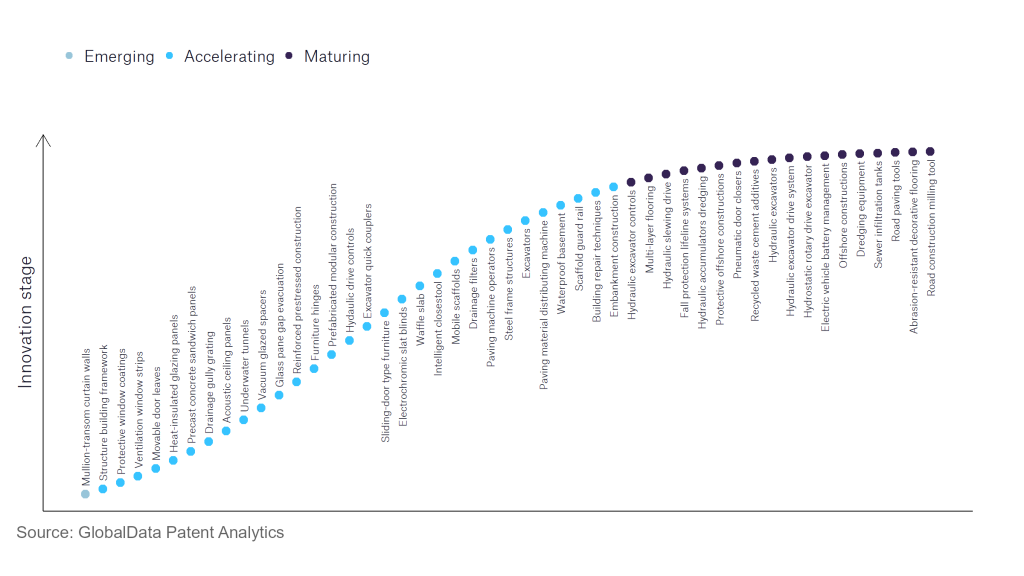The construction industry continues to be a hotbed of innovation, with activity driven by an increased focus on environmental sustainability and workplace safety, and the growing importance of technologies such as the Internet of Things (IoT) and robotics. In the last three years alone, there have been over 248,000 patents filed and granted in the construction industry, according to GlobalData’s report on Innovation in Construction: Hydraulic excavators. Buy the report here.
However, not all innovations are equal and nor do they follow a constant upward trend. Instead, their evolution takes the form of an S-shaped curve that reflects their typical lifecycle from early emergence to accelerating adoption, before finally stabilising and reaching maturity.
Identifying where a particular innovation is on this journey, especially those that are in the emerging and accelerating stages, is essential for understanding their current level of adoption and the likely future trajectory and impact they will have.
80+ innovations will shape the construction industry
According to GlobalData’s Technology Foresights, which plots the S-curve for the construction industry using innovation intensity models built on over 179,000 patents, there are 80+ innovation areas that will shape the future of the industry.
Within the emerging innovation stage, mullion-transom curtain walls is the disruptive technology that is in the early stages of application and should be tracked closely. Heat-insulated glazing panels, drainage gully grating, and acoustic ceiling panels are some of the accelerating innovation areas, where adoption has been steadily increasing. Among maturing innovation areas are abrasion-resistant decorative flooring and road construction milling tool, which are now well established in the industry.
Innovation S-curve for the construction industry

Hydraulic excavators are a key innovation area in construction
Hydraulic excavators are heavy construction equipment designed for digging and earthmoving purposes. They consist of a cab, an arm, and a digging bucket attached to a hydraulically rotating platform called the house, which is mounted on an undercarriage with tracks or wheels for mobility. The arm and bucket are powered by hydraulic cylinders, which use pressurised fluid to generate the necessary force to move the digging implements.
GlobalData’s analysis also uncovers the companies at the forefront of each innovation area and assesses the potential reach and impact of their patenting activity across different applications and geographies. According to GlobalData, there are 30+ companies, spanning technology vendors, established construction companies, and up-and-coming start-ups engaged in the development and application of hydraulic excavators.
Key players in hydraulic excavators – a disruptive innovation in the construction industry
‘Application diversity’ measures the number of different applications identified for each relevant patent and broadly splits companies into either ‘niche’ or ‘diversified’ innovators.
‘Geographic reach’ refers to the number of different countries each relevant patent is registered in and reflects the breadth of geographic application intended, ranging from ‘global’ to ‘local’.
Patent volumes related to hydraulic excavators
Source: GlobalData Patent Analytics
One of the leading companies in the hydraulic excavator space is Kubota. A recent innovation proposes an alternative to open and closed-circuit systems for hydraulic motors through the use of a hydraulic drive comprising a hydraulic motor that includes a first and second hydraulic connector. The motor will convert hydraulic energy into mechanical energy and is driven by a difference in pressure between the first and second connectors. The rotary movement generated by the hydraulic motor is then determined by the displacement volume of the hydraulic motor and by the quantity of the hydraulic fluid flowing through the hydraulic motor. Other leading companies in the space include Liebherr and HUSCO International.
In terms of application diversity, the leading companies are Takeuchi and Syn Trac, while in terms of geographic reach, the leading companies include Syn Trac, Kubota, and Sany.
To further understand the key themes and technologies disrupting the construction industry, access GlobalData’s latest thematic research report on Construction.
Data Insights
From

The gold standard of business intelligence.
Blending expert knowledge with cutting-edge technology, GlobalData’s unrivalled proprietary data will enable you to decode what’s happening in your market. You can make better informed decisions and gain a future-proof advantage over your competitors.



